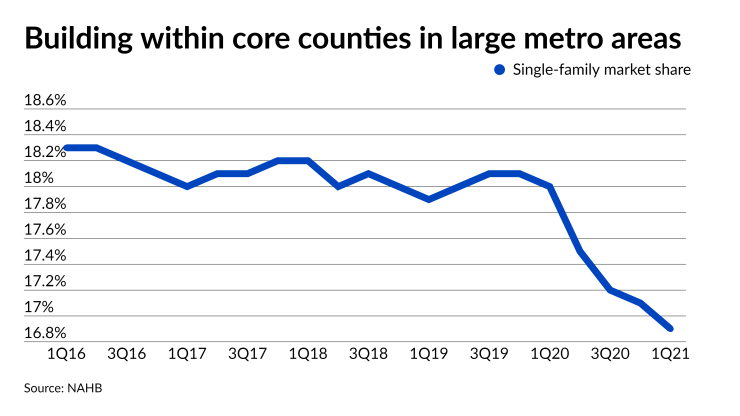Builders are returning to markets with
Home construction in the segment of the single-family market with the shortest trips to work is growing the fastest with a four-quarter average of more than 22%, according to a recent report by the National Association of Home Builders. However, the two-fifths representing the longest commutes dominated the market in the first quarter with a combined share of nearly 64%.

The NAHB’s Home Building Geography Index report and other data seen so far suggest that the vaccine rollout and opening up of the economy may only go so far when it comes to reversing
“We expect a partial rollback to some of these effects [from the pandemic] as we move into 2021,” Dietz said.
Evidence of a rollback lies in a separate NAHB study that shows townhome construction recently experienced its biggest quarterly surge in over two years, Dietz said. That occurred in the fourth quarter of last year, when townhouses represented an 11.4% share of single-family starts. The townhome share so far appears to be relatively strong going into 2021, he said.
“The fact that builders were starting construction on the largest number of townhouses in two-and-a-half years is an indication that builders are expecting some of the demand to roll back into medium density or walkable areas,” he said. Other researchers also have noted a
That said, the NAHB’s more recent analysis of commuter trends suggests the intensified shift toward more distant areas due to the pandemic was large enough that it may not be quickly reversed. Dietz points to a year-over-year first-quarter drop in the market share for single-family building in core counties within metropolitan areas to 16.9% from 18% as evidence of this. Core counties are close-in suburbs within metro areas that tend to have short commute times.
“When we look at the data over years, these market shares tend not to move around a whole lot, so that actually is a fairly significant decline,” Dietz said. The numbers show that the share of building in these areas was wavering a little prior to the pandemic due to
The Home Building Geography Index report, which the NAHB started last year, examines building activity relative to commuting time for various markets based in part on the 2019 American Community Survey produced by the Census Bureau. (The 2020 ACS has not yet been released.)
The index played a key role in the past year when it comes to proving that the pandemic and the rise in remote work did move the needle for the housing market, Dietz said.
“There were some analysts who swore up and down that the idea of any kind of geographic shift in housing demand was a myth. I think the evidence now for the shift in housing demand that occurred in 2020 is incontrovertible,” he said.
While the pandemic and the rise in remote work clearly had an effect on the relationship between commute times and housing nationally, it hasn’t been universal. Communities that don’t have broadband, for example, haven’t had the option of working remotely, said Paul Angelone, senior director of the Urban Land Institute’s Curtis Infrastructure Initiative, in an interview.
“I think people still want to be in walkable, urban places and I still think there’s a lot of demand for those. A lot of developers are still bullish and optimistic that cities still are good places to invest and also are thinking about where well-connected suburban areas are that can still grow. But a lot of rural communities just don’t have broadband, and if you want to have a virtual office, you need it,” he said.


